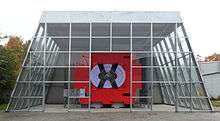ARGUS (experiment)
ARGUS (A Russian-German-United States-Swedish Collaboration; later joined by Canada and the former Yugoslavia) was a particle physics experiment that ran at the electron-positron collider ring DORIS II at DESY. Its aim was to explore properties of charm and bottom quarks. Its construction started in 1979, the detector was commissioned in 1982 and operated until 1992.[1]

The ARGUS detector at DESY research facility, exposed as an exhibit after decommissioning.

Detailed image of the ARGUS detector.
The ARGUS detector was a hermetic detector with 90% coverage of the full solid angle. It had drift chambers, a time-of-flight system, an electromagnetic calorimeter and a muon chamber system.[2]
It is the first experiment that observed the mixing of the B mesons (in 1987).[3] The ARGUS distribution is named after the experiment.
External links
- Webpage of ARGUS Fest, a symposium to commemorate the 20th anniversary of the discovery of B-meson oscillations. (Last accessed on Sept. 10, 2007)
References
- ARGUS Fact Sheet, exposed in the detector hall at DESY
- Albrecht, H.; Binder, U.; Böckmann, P.; Drews, G.; Gläser, R.; et al. (The ARGUS Collaboration) (1989). "Argus: A universal detector at DORIS II". Nuclear Instruments and Methods in Physics Research Section A: Accelerators, Spectrometers, Detectors and Associated Equipment. Elsevier BV. 275 (1): 1–48. doi:10.1016/0168-9002(89)90334-3. ISSN 0168-9002.
- Albrecht, H.; Andam, A.A.; Binder, U.; Böckmann, P.; Gläser, R.; et al. (ARGUS Collaboration) (1987). "Observation of B0-B0 mixing". Physics Letters B. Elsevier BV. 192 (1–2): 245–252. doi:10.1016/0370-2693(87)91177-4. ISSN 0370-2693. DESY preprint 87-029
This article is issued from Wikipedia. The text is licensed under Creative Commons - Attribution - Sharealike. Additional terms may apply for the media files.